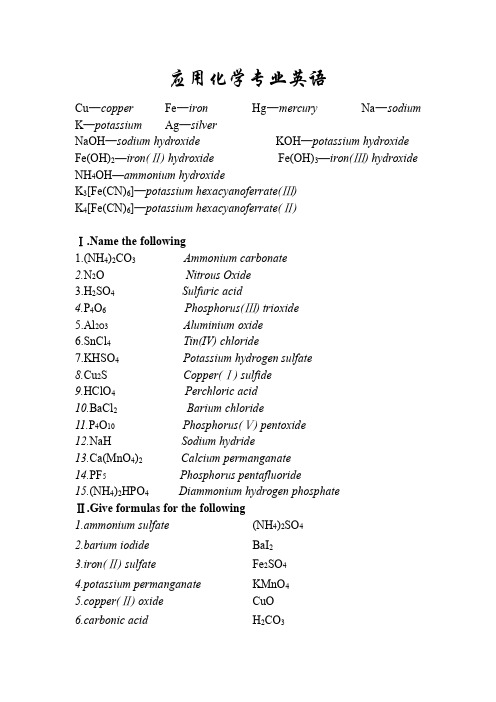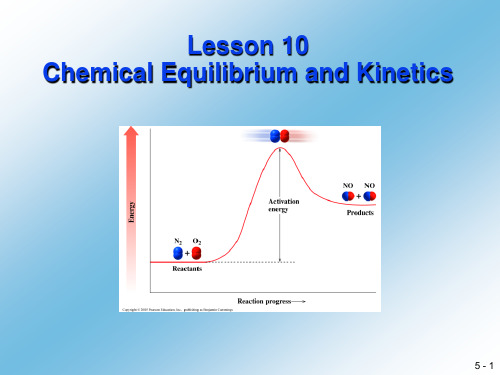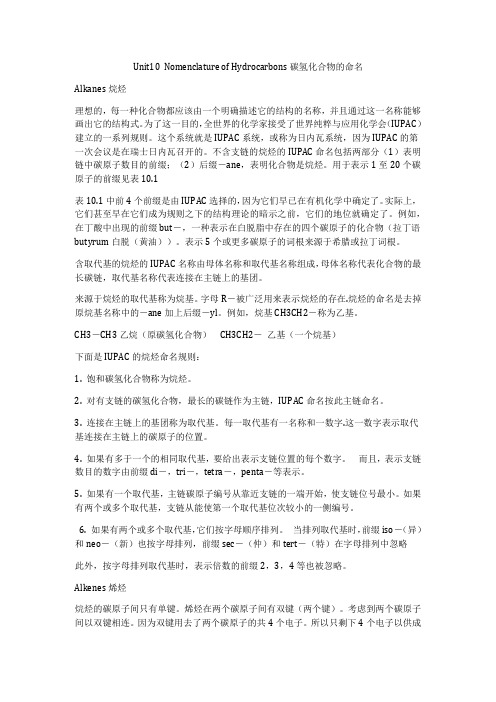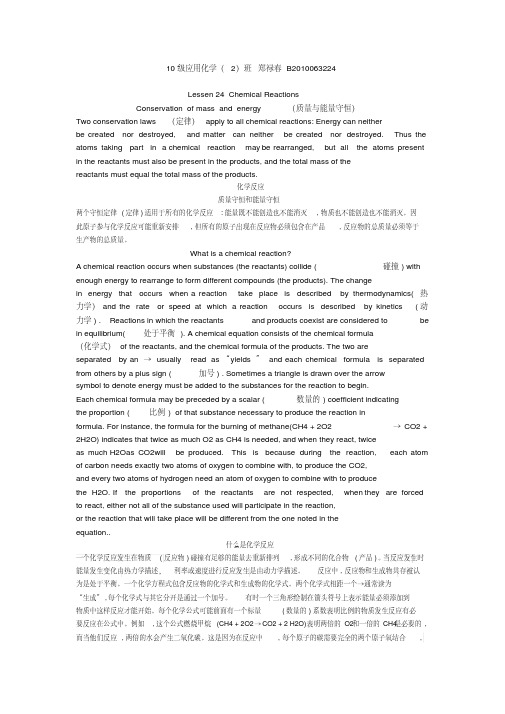应用化学专业英语lesson10ChemicalEquilibriumandkinetics
应用化学专业英语

应用化学专业英语Cu—copper Fe—iron Hg—mercury Na—sodium K—potassium Ag—silverNaOH—sodium hydroxide KOH—potassium hydroxide Fe(OH)2—iron(Ⅱ)hydroxide Fe(OH)3—iron(Ⅲ)hydroxide NH4OH—ammonium hydroxideK3[Fe(CN)6]—potassium hexacyanoferrate(Ⅲ)K4[Fe(CN)6]—potassium hexacyanoferrate(Ⅱ)Ⅰ.Name the following1.(NH4)2CO3Ammonium carbonate2.N2O Nitrous Oxide3.H2SO4Sulfuric acid4.P4O6Phosphorus(Ⅲ)trioxide5.Al2O3Aluminium oxide6.SnCl4Tin(IV)chloride7.KHSO4Potassium hydrogen sulfate8.Cu2S Copper(Ⅰ)sulfide9.HClO4Perchloric acid10.BaCl2Barium chloride11.P4O10Phosphorus(Ⅴ)pentoxide12.NaH Sodium hydride13.Ca(MnO4)2Calcium permanganate14.PF5Phosphorus pentafluoride15.(NH4)2HPO4Diammonium hydrogen phosphateⅡ.Give formulas for the following1.ammonium sulfate(NH4)2SO42.barium iodide BaI23.iron(Ⅱ)sulfate Fe2SO44.potassium permanganate KMnO45.copper(Ⅱ)oxide CuO6.carbonic acid H2CO3Melting point 熔点boiling point 沸点1.Which particles play the most active role in chemical bonding?(a)electrons (b)neutrons (c)protons (d)valence electrons2.An ionic bond is formed when electrons are:(a)completely destroyed (b)compeltely transferred (c)divied (d)equally shared3.Due to the that Ionic compounds have strong intermolecular forces they are at room temperature.(a)bonded covalently (b)gases (c)liquids(d)solids 1-butene trans -2-butenecis -2-butene iso -butene (E )-2-butene (Z )-butene 2-methylpropene1.Draw structure that correspond to the following names.(a)2,2-dimethylpentane (b)4-isobutyl-2,5-dimethylheptane (c)(Z)-3-menthyl-2-octene (d)(2R,3S)-2,3-pentanediol2.Give the IUPAC name for each of the following structures.(e)(f)(E)-1-methyl-4-ethylcyclohexane(g)(h)(S)-2-chloro-butyraldehyde (2R,3R)-2,3-dichlorobutyric acid补充:(E)-2-chloro-3-methyl-2-octene Nucleophile亲核试剂carbocation碳阳离子Compressible可压缩的incompressible不可压缩的1.A chemical system can be studied from either a or a(n)viewpiont.(A)physical...chenical(B)molecual...atomic (C)Microscopic...macroscopic(D)Mechanic...kinetic2.Is a macroscopic science that studies the interrelationships between the various equilibrium properties of a stystem.(A)Kinetics(B)Thermodynamics (C)Statistical mechanics(D)Quantum chenistry3.In,the molecular and macroscopic levels are related to each other.(A)quantum(B)statistical(C)thermodynamics(D)kinetics4.thermodynamics studies.(A)heat,work,energy,and the changes they produce in the states of systems(B)The relationships between the molecules of a system(C)heat,work,temperature,and the energy they produce in the states of systems(D)heat,energy,and work5.For a(n)system,neither matter nor energy can be transferred between system and surroundings.(A)closed(B)open(C)isolated(D)none of the aboveⅠ.Translate the following from English into Chinese.(1)pollution of the atmosphere(2)nondegradable pollutant大气污染不可降解污染物(3)harmless pollutant(4)interacting chemicals无害污染物相互作用的化学物质(5)threshold level(6)sound pressure level限定值,阈值声压水平(7)speech interference(8)transmission path 语音干扰传输途径Translate the following from Chinese into English.(1)定性分析qualitative analysis (2)分析物analyte (3)准确度accuracy (5)反应速率reaction-rate (5)解吸附作用deserption (6)吸附absorption conduction 热传导convection 对流radiation 辐射Balance and classify each of the following chemical equations as a (1)combination reactions ,(2)decomposition reaction ,(3)displacement reaction ,or (4)partner-exchange reaction.(a))()(2243l O H s Fe H O Fe +→+)(4)(342243l O H s Fe H O Fe +→+displacement reaction 置换反应(b))()()(23g O s KCl s KClO +→)(3)(2)(223g O s KCl s KClO +→decomposition reaction 分解反应(c)steam and hot carbon react to form gasecous hyfrogen and gaseous carbon monoxide.)()()()(22g CO g H s C l O H +→+displacement reaction 置换反应(d))()()(4272aq HClO g O H g O Cl →+)(2)()(4272aq HClO g O H g O Cl →+combination reactions 化合反应(e))()()(22aq HBrO aq HBr O H l Br +→+)()()(22aq HBrO aq HBr O H l Br +→+decomposition reaction 分解反应(f))()()()()(43442243aq PO H s CaSO aq SO H s PO Ca +→+)(2)(3)(3)()(43442243aq PO H s CaSO aq SO H s PO Ca +→+partner-exchange reaction 复分解反应(g)Potassium reacts with water to give aqueous potassium hydroxide and gaseous hydroxide.)()(2)(2)(222g H aq KOH l O H s K +→+displacement reaction 置换反应(h)Solid magnesium carbonate decomposes to form solid magnesium oxide and gaseous carbon monoxide.)()()(23g CO s MgO s MgCO +→decomposition reaction 分解反应Abstract 摘要Results and discussion 结果与讨论Experimental实验References参考文献E-factor影响因素Journal of the American Chemical Society美国化学会志Journal of the Chemical Society化学会志Journal of Organic Chemistry有机化学杂志Tetrahedron四面体'\.._/ ( Wb川ache mical reaction?Acherr山al react i on occurs when subs'孟忘"(tlie reactants) collide (碰撞) with enough energy to rearrange to form different compounds (由e produc时. η1e change in energy由at occurs when a reaction take place is described by thermodynamics (热力学) and the rate or speed at which a reaction occ u rs is described by kfaetics (动力学) . Reactions in which the reactants and produc臼coexist are considered to be in equ山brium (处于平衡). A chemical equation consists of the chemical formula (化学式) of the reactants,且目the chemical formula of the products. The two are separated by an 一一- usually read as ”yielas·’and each chemical formula is separated from others by a plus sign (加号) . Sometimes a triangle is drawn over the arrow symbol to denote energy must be added to the substances for the reaction to begin. Each chemical formula may be preceded by a scalar (数量的) coefficient ind i cating the proportion (比例) of that substance necessary to produce the reaction in formula. For instance, the formula for the burning of methane (C比+ 202 →C02 + 2H20) indicates that twice as much 02 as C比is needed, and when they react, twice as much H20 as C02 will be produced.η1is is because during the reaction, each atom of carbon needs exactly two atoms of oxygen to combine with, to produce the C02, and every two atoms of hydrogen need an atom of oxygen to combine with to produce the H20. If the proportions of t he reactants are not respected, when they are forced to react, either not all of the substanc e used will participate in the react i on, or the react i on that will take p l ace will be different from the one noted in the equation.。
应用化学专业英语lesson10ChemicalEquilibriumandkinetics

NH3
Add more NH3?
Reaction shifts to the left [N2] and [H2] inc
5 - 35
Le Chatelier’s principle
Adding Pressure affects an equilibrium with gases
N2(g) + 3 H2(g)
N2(g) + 3 H2(g)
Keq =
[ NH3 ] 2 [ N2 ] [ H2 ] 3
2 NH3(g)
5 - 33
Le Chatelier’s principle
Stress causes shift in equilibrium Adding or removing reagent
N2(g) + 3 H2(g)
Temperature: 2. Higher Temperature:
Faster cars More collisions
More Energy More collisions
Reacting molecules move faster, providing colliding molecules w/ Eact.
At this point, equilibrium is achieved. Time
5 - 26
Figure 9.8
2SO2(g) + O2(g)
At Equilibium
2SO3(g)
SO2(g)+O2(g)
Initially
SO3(g)
Initially
5 - 27
Figure 9.9
2SO2(g) + O2(g)
应用化学专业英语翻译(第二版)

Unit10 Nomenclature of Hydrocarbons碳氢化合物的命名Alkanes烷烃理想的,每一种化合物都应该由一个明确描述它的结构的名称,并且通过这一名称能够画出它的结构式。
为了这一目的,全世界的化学家接受了世界纯粹与应用化学会(IUPAC)建立的一系列规则。
这个系统就是IUPAC系统,或称为日内瓦系统,因为IUPAC的第一次会议是在瑞士日内瓦召开的。
不含支链的烷烃的IUPAC命名包括两部分(1)表明链中碳原子数目的前缀;(2)后缀-ane,表明化合物是烷烃。
用于表示1至20个碳原子的前缀见表10.1表10.1中前4个前缀是由IUPAC选择的,因为它们早已在有机化学中确定了。
实际上,它们甚至早在它们成为规则之下的结构理论的暗示之前,它们的地位就确定了。
例如,在丁酸中出现的前缀but-,一种表示在白脱脂中存在的四个碳原子的化合物(拉丁语butyrum白脱(黄油))。
表示5个或更多碳原子的词根来源于希腊或拉丁词根。
含取代基的烷烃的IUPAC名称由母体名称和取代基名称组成,母体名称代表化合物的最长碳链,取代基名称代表连接在主链上的基团。
来源于烷烃的取代基称为烷基。
字母R-被广泛用来表示烷烃的存在.烷烃的命名是去掉原烷基名称中的-ane加上后缀-yl。
例如,烷基CH3CH2-称为乙基。
CH3-CH3乙烷(原碳氢化合物)CH3CH2-乙基(一个烷基)下面是IUPAC的烷烃命名规则:1. 饱和碳氢化合物称为烷烃。
2. 对有支链的碳氢化合物,最长的碳链作为主链,IUPAC命名按此主链命名。
3. 连接在主链上的基团称为取代基。
每一取代基有一名称和一数字.这一数字表示取代基连接在主链上的碳原子的位置。
4. 如果有多于一个的相同取代基,要给出表示支链位置的每个数字。
而且,表示支链数目的数字由前缀di-,tri-,tetra-,penta-等表示。
5. 如果有一个取代基,主链碳原子编号从靠近支链的一端开始,使支链位号最小。
东华大学-应用化学-专业英语

第二课 无机化合物及化学式的命名
化学式书写的基本规则 如何写化学式 命名化合物 二元化合物:氧化物,盐,酸
(1)阴离子元素加后缀 –ide (2)多价态元素加前缀:mono-, di-, tri-, tetra-, penta-, hexa(3)低价氧化态后缀 –ou]朱红军,吕志敏.应用化学专业英语教程[M].北 京:化学工业出版社,2005. [2]万有志,王幸宜.应用化学专业英语[M].北京:化 学工业出版社,2008 (第二版). [3]丁慧,马晓燕.应用化学化工专业英语[M].哈尔 滨:哈尔滨工程大学出版社,2007. 讲 读 写 说 练 查
反应机理: reaction mechanisms 均相催化剂: homogeneous catalysis 非均相催化剂: heterogeneous catalysis 平衡常数: the equilibrium constant 反应方向: the direction of reaction 自发过程:spontaneous processes 标准熵: standard entropy 熵变: entropy changes 标准自由能变: standard free-energy changes 酸-碱: acid-bases 水离解: the dissociation of water pH值范围: the pH scales 质子转移反应: proton transfer reactions 共轭酸碱对: conjugate acid-base pairs 金属离子的水解: hydrolysis of metal ions 缓冲溶液: buffer solution 同离子效应:the common-ion effects
相关单词
应用化学专业英语 复习总结

英译汉:1.First, electrons are added one at a time moving from left to right across a period……首先,从左向右横跨一个周期时每次增加一个电子。
当这种情况发生时,最外层电子将受到逐渐增强的核引力,所以电子将更接近原子核而受到其更紧密的束缚力。
其次,在周期表中从上向下移动一列,最外层电子受到核的束缚力将变弱。
这是因为主能级数(屏蔽最外层电子受到核的吸引)在每族向下移动时增加。
这些趋势解释了通过观察元素的原子半径、电离能、电子亲和力和电负性而得到的元素性质的周期性规律。
2.It is important to note that at equilibrium the rates of reaction,rate r and rate f are equilibriummixture are usually not equal……值得注意的是,在化学平衡时的反应速率,正反应速率和你反应速率相等但反应物和生成物的摩尔浓度在平衡混合态时一般不相等。
但是,事实上每种反应物和生成物在平衡时其浓度为定值,因为每种物质在一个反应中的消耗速率与其在相应你反应正的生成速率相等。
在化学平衡提出之前,这种系统被称为动力学平衡状态。
3.This is a mathematical expression of the law of chemical equilibrium which may be stated as follows:When a reversible…………这是化学平衡定律的数学表达式,它可以通过如下所述:当一个可逆反应在给定温度下达到平衡时,在方程式中箭头右边物质的摩尔浓度的积除以左边物质摩尔浓度的积(每种物质浓度的幂等于反应方程式中每种物质的分子数)为定值,4.Analytical chemistry,or the art of recognizing different substances and determining theirconstituents, takes a prominent position among分析化学或鉴定不同物质并测定其成分的技术,因为可以解决每当化学过程被用于科学的或技术性的目的是产生的问题,而在科学应用领域中占显著地位。
应用化学专业英语翻译

10级应用化学(2)班郑禄春 B2010063224Lessen 24 Chemical ReactionsConservation of mass and energy(质量与能量守恒)Two conservation laws(定律) apply to all chemical reactions: Energy can neitherbe created nor destroyed, and matter can neither be created nor destroyed. Thus the atoms taking part in a chemical reaction may be rearranged, but all the atoms present in the reactants must also be present in the products, and the total mass of thereactants must equal the total mass of the products.化学反应质量守恒和能量守恒两个守恒定律(定律)适用于所有的化学反应:能量既不能创造也不能消灭,物质也不能创造也不能消灭。
因此原子参与化学反应可能重新安排,但所有的原子出现在反应物必须包含在产品,反应物的总质量必须等于生产物的总质量。
What is a chemical reaction?A chemical reaction occurs when substances (the reactants) collide (碰撞) with enough energy to rearrange to form different compounds (the products). The changein energy that occurs when a reaction take place is described by thermodynamics(热力学)and the rate or speed at which a reaction occurs is described by kinetics (动力学) . Reactions in which the reactants and products coexist are considered to be in equilibrium(处于平衡). A chemical equation consists of the chemical formula(化学式)of the reactants, and the chemical formula of the products. The two areseparated by an →usually read as “yields”and each chemical formula is separated from others by a plus sign (加号) . Sometimes a triangle is drawn over the arrowsymbol to denote energy must be added to the substances for the reaction to begin.Each chemical formula may be preceded by a scalar (数量的) coefficient indicatingthe proportion (比例) of that substance necessary to produce the reaction informula. For instance, the formula for the burning of methane(CH4 + 2O2 → CO2 + 2H2O) indicates that twice as much O2 as CH4 is needed, and when they react, twiceas much H2O a s CO2 w ill be produced. This is because during the reaction, each atom of carbon needs exactly two atoms of oxygen to combine with, to produce the CO2,and every two atoms of hydrogen need an atom of oxygen to combine with to producethe H2O. If the proportions of the reactants are not respected, when they are forced to react, either not all of the substance used will participate in the reaction,or the reaction that will take place will be different from the one noted in theequation..什么是化学反应一个化学反应发生在物质(反应物)碰撞有足够的能量去重新排列,形成不同的化合物(产品)。
应用化学专业英语第二版万有志主编版主要课文翻译
1化学的起源化学可以被广泛的定义为分子的科学和它们之间的转换。
和数学不同,化学在人类之前。
我们的星球(地球)上的生命和人类的外观很可能是化学进程的具体结果。
化学过程从历史的开端一直到现在都出现在人们的生活中。
最初,这些过程不在我们的掌控之中,例如,果汁的发酵,肉和鱼的腐烂,木头的燃烧。
后来我们学着去控制化学进程使用它来生产不同的产品,比如食物,金属,陶瓷和皮革。
在化学的发展上,主要区分为四个阶段:史前化学,希腊化学,炼金术,科学化学。
早期的化学很明显是被人们实际需要所激发的。
火的发现提供了史前人类开始控制化学反应的一次机会。
他们合成一些黄铜,青铜和其他易得材料的物品。
因为人类早期对化学过程的应用早于记载,所以没有关于它们化学技能的记录。
唯一可以判断它们化学能力的是考古的发现和不同的人造品。
正如早期数学发展一样,实际需要影响着化学的发展。
但是化学和数学在这个阶段很可能没有关系。
即使有,也没有记录来确定这些。
希腊化学主要建立在推测的基础上而不是在实验的基础上。
这是古希腊所有科学的普遍特征。
古希腊科学家实际上是哲学家,所以希腊对思考如此感兴趣盛于实验也就不足为奇了。
事实上他们很少做思考之外的实验。
这对数学是一个好的方法但是却不是对于物理,化学和生物科学。
然而,希腊人思考了许多关于自然和物质结构,他们可以被看作早期化学理论的创造者。
希腊引进了元素的概念总共提出了四种元素。
Thalesren认为所有的东西来自一种基本的物质,就是水。
Anaximenes,接受了元素的概念,但他认为来单独的元素自于空气中的物质。
Heraclitus,认为宇宙的基本的特点是不断变化的,把火作为永久变化的元素。
Empedocles摒弃了了单独元素的概念并引进了四种元素:水,空气,火和土,他也因为他的实验证明了空气是一种物质结构而出名。
火这种元素最早被柏拉图引用他猜测每种元素的粒子有特定的形体,尽管这种粒子太小以至于看不见。
因此,火的最小的粒子有规则的四面体结构,空气是八面体,水是二十面体,土是立方体(主要是六面体)。
应用化学专业英语经典题
1. Hydrogen is prepared by means of _D___ reaction in lab.(a) substitution (b) decomposition (c) addition (d) displacement2. Benzene reaction with Cl2 belongs to __A__a) substitution (b) decomposition (c) addition (d) displacement3. The __C__ elements from monoatomic molecules due to their filled valent electronic configurations.(a) representative (b) transition element (c) inert gas (d) p-block4. Alkenes are produced in __B__ reaction as described below(a) addition (b) elimination (c) displacement (d) substitution5. The __C__ structure of CH4 has been verified by electron diffracxtion because of sp3 hybridization.(a) flat square (b) parellel tetragonal (c) tetrahedral (d) tetragonal6. The octet rile simoly states that an atom tends to gain or lose electrons until there are __B__ electrons in its valent shell(a) 12 (b) 8 (c) 6 (d) 127. When water combines with pure CuSO4, a __B__ forms(a) hydrogenate (b) hydrate (c) hydrocarbon (d) hydride8. Lyophobic colloid generally have _A___ identity between their molecules and solvent molecules.(a) attraction (b) electrostatic force (c) repulsion (d) electronegativity9. Which of the following has minimum ionization energy D(a) Li (b) Na (c) K (d) Rb10. The seawater is saline solution. To desalinate seawater is the process to _D___ salt component(a) add (b) dilute (c) concentrate (d) remove11. There are(is) __A_ paired electrons in hydrogen(a) 1 (b) 2 (c) 3 (d)412. The valent electronic configuration for fluorine is __C___(a) 1s2 (b) 2s2 (c) (d) is2. 2s2, 2p513. The octet means that the number of electrons in _C___ shell has to be eight.(a) innermost (b) the whole (c) outermost (d) no14. Polysaccarides like cellulose and starch must first be subjected to _A__ to form simpler sugar, such as monosaccarides.(a) dehydration (b) composition (c) hydrolysiis (d) comparsion15. Which of the following belongs to transition metal D(a) S (b) Na (c) He (d) V16 Addition of AgNO3 in a solution generates white AgCl __C__ that does not dissolve in HNO3(a) solvent (b)silica-gel (c) precipitate (d) solvent1. The nature of organic species present depends on the degree of biochemical change of the original plant, C(a) pattern (b) fractions (c) substances (d) ceramics2. I(py)2+ appears to be present in solution C(a) be made (b) be dissolved (c) be detected (d) occurM-F-M bridge bonds invariably have greater M-F distances than corresponding terminal M-F bonds. C(a) seldom (b) strongly (c) usually (d) never4. The chemical potential decreases and both the effect, ., solubility and normal temperature effect. B(a) for example (b) that is to say (c) through (d) approximatelyM-F-M bridge bonds invariably have greater M-F distances than corresponding terminal M-F bonds. A(a) end (b) head (c) initial (d) intermediate6. The corresponding bromine-and chlorine-species are less stable. B(a) compound (b) substances (c) supports (d) elementsH2O2, hydrogen peroxide Na2O2, sodium peroxide Se, selenium F , fluorine Br2, brominePCl3, phosphorus trichloride HI, hydrogen iodide AgI, silver iodide I2, iodine I-, iodideICl3, iodine trichloride Br-, bromide NF3, nitrogen trifluoride ClF7, chlorine heptafluoride CCl4, carbon tetrachloride PF3, phosphorus trifluoride Cl2O7 dichlorine heptoxideHydration--combination with water molecules.1. The _A___ ion can be considered s hydrated proton, H3O+.(a) hydrogen (b) hydroxyl (c) hydronium (d) hydroxo2. Chlorine is bubbled into aqueous sodium bromide, __A__ is liberated(a) bromine (b) dibromide (c) bromide (d) bromide ion3. Which of the following is diatomic molecule D(a) He (b) Ne (c) Ar (d) H24. Which of the following is oxoanion C(a) S2-, (b) HS-, (c) SO42-, (d) H2S1. In addition, for first order model the intercept of the straight line plots of log(qe-qt)against t B(a) therefore (b) Furthermore (c) But (d) Actually2. Most fluorine compounds are obtained from fluorspar via HF B(a) in (b) through (c) of (d) containingSnCl4, tin(IV) chloride FeCl3, iron(III) chloride PbCl4, lead(IV) chloride Sn2+,tin(II) ionCaCl2, calcium chloride I3-, triiodide ion CdCl2, cadmium chloride S2-,sulfide ionHgCl2, mercury(II) chloride FeO, iron(II) oxide Cu2O, copper(I) oxide O2-,oxide ionAlCl3, aluminium chloride CBr4, carbon tetrabromide CdS, cadmium sulfide S22-,disulfide ionZnO, zinc oxide V5+, vanadium(V) ion Cr3+, chromium(III) ion SiO2, silicon dioxideSnCl2, tin(II) chloride H+, hydrogen ion Mg2+, magnesium ion O22-, peroxide ionK+, potassium ion Be2+, beryllium ion Tl+, thallium(I) ion Ti4+, titanium(IV) ionPb2+, lead(II) ion Br-, bromide ion Se2-, selenide ion Ca2+, calcium ion Fe2+, iron(II) ionSn4+, tin(IV) ion Hg2Cl2, mercury(I) dichloride Al3+, aluminium ion1. The diversity of carbon compound is duo to formation of very long chain of carbon atom by the strong carbon-carbon __D__ bond(a) ionic (b) metallic (c) hydrogen (d) covalent2. An inportant quantity, particular for first-order reaction, is _B___ , the length of time required for the concentration of reactant to be decreases to half of its initial value(a) filled (b) half-life (c) half-filled (d) partiallly-filled3. In alkane of CH3CH2CH3, there are _D___ substituents.(a) 2 (b) 3 (c) 8 (d) no4. In alkane CH3Ch2CH3, there are __B__ carbons in parent chain(a) 2 (b) 3 (c) 8 (d) 85. Environment preotection is a global process which has also included pollution of aquasphere, ., __B__ is polluted.(a) soil (b) water (c) chemical reagent (d) atmosphere3. Reaction of sodium carbonate with dilute sulfuric acid will generate __A__.(a) a gas (b) a precipitate (c) aqueous solute (d) emulsionCH2BrCH=C(CH3)CH2CH2CH3, 1-bromo-3-methyl-2-hexene CH3(CH2)10CH3, dodecaneCH3CH=CHCH3, 2-butene CH3(CH2)16CH3, octadecane CCl2=CCl2 tetrachloroetheneCH3CH=CHCH2CH3 2-pentene CH3CH2CH3 propane CH2=CH2 ethenetrans-3-hexene3-ethyl-4-methylhexanezinc chloride hexahydrate zinc sulfate heptahydrateRbMgCl3 magnesium rubidium chloride calcium sulfate dihydrateH4P2O7 diphosphoric acid cadmium chloride hexahydrateCu2(OH)2CO3 copper(II) hydroxide carbonate CsCo(SO4)2 cesium cobalt sulfateH2S2O7 disulfuric acid iron(II) sulfide heptahydrate(NH4)2Fe(SO4)2 ammonium iron(II) sulfate K2Cr2O7 potassium dichromatesodium sulfate decahydrate KMnO4, potassium permanganateK2MnO4, potassium manganate MnO4-, permanganate ion MnO2 manganese(IV) oxideCrO3, chromium(VI) oxide CrO42-, chromate ion K2CrO4, potassium chromateCr2O3, chromium(III) oxide H2SO4. Sulfuric acid H2SO3. Sulfurous acid H2S(aq), hydrosulfuric acid As2S3, diarsenic trisulfide H2S(as a gas), hydrogen sulgideSF6, sulfur hexfluoride NaHSO3, sodium hydrogen sulfite HCl(a gas), hydrogen chlorideNaHSO4, sodium hydrogen sulfate ClO3-. Chlorate ion HClO3, chloric acid HCl(aq), hydrochloric acid KVO3, potassium vanadate HVO3, vanadic acid V2O5, divanadium pentoxide VCl3, vanadium(III) chloride Al(NO3)3, aluminium nitrateNaAlO2,sodium alumate Al(OH)3, aluminium hydroxide Fe(NO3)3, iron(III) isopropylcyclohexanetert-butylcyclohexane2-ethyl-1-isobutylcyclohexanecyclopentanecyclopropanenitrateCa(BrO2)2, calcium bromite Na2S, sodium sulfide I-, iodide ion IO2-, ioditeionH2MnO4, manganic acid CaCl2, calcium chloride Na2SO3, sodium sulfiteKI, potassium iodide KIO2, potassium iodite HBrO, hypobromous acidNaBrO, sodium hypobromite NaBr, sodium bromide NaBrO3, sodium bromateKPO3,potassium phosphorate HPO3, metaphosphoric acid K3PO4, potassium phosphorate H3PO4 phosphoric acidm=chlorofluorobenzeneP-bromochlorobenzenem-nitroiodobenzenemethylenecyclohexanem-methylphenol(1-menthylvinyl)benzene 2-methyl-1-penten-3-y2-chloro-1,3-butadi2-propanol 2,4-hexadiyne-1,6-diol2,4-hexadiene-1,6-diol4-hexen-2-olcis-1,2-dimethyl-1,2-cyclopentatrans-1,2-dimethyl-1,2-cyclopent2-propynol1,3-cyclohexadiene(1-methylvinyl)cyclopentanebenzylcyclohexanephenylcyclohexane diphenylmethane1-penten-3-yne 2,5-heptadiyne 1,3-diphenylpropaneCyclohexane-1,2-diol2,5-cyclohexadiene-1,44-hexene-1,2-diolallylbenzene vinylcyclohexane3-butynal ethanenitrilcyclohexanecarboxylic acid cyclohexanedicarboxylic1,2-cyclohexanedinitrile ethanamide ethanyl chloridesec-butylethanoate4-methoxyphenol 2,5-hexanedione dimethyl1. Alkenes and alkynes are classified into __B_ compound(a) cyclic (b) unsaturated (c) aromatic (d) straight chain2. The general formula R-C=N-O is called cyanate, while R-N=C=O is called _B__(a)cyano (b) isocyanate (c)nitrile (d) cyanide3. Reaction between __C__ chloride and sodium hydroxide will release a pungent gas.(a) amino (b) amine (c) ammonium (d) ammonia4. Which of the following belons to triprotic acid D(a) HNO3 (b) H2SO4 (c) HNO2 (d) H3PO45. Animal and vegetable oil and fat are a more specialized source of a limit number of __C__ compounds, including fatty acid such as CH3(CH2)16COOH and a long chain alcohol as CH3(CH2)11OH(a) petroleum (b) inorganic (c) aliphatic (d) aromatic6. The general term for species that is active in the interface medium between phase is ___A__.(a) a surfactant (b) a nucleophile (c) an electrolyte (d) an electrophile--------------------------------------------------------------------------1,4-butanedithioldimethyl ethanedioatetetrabutylammonium hydroxidemethanal2-chloro-1,3-butadiene1,3-propanediol2-propanol2-aminophenol3-methylphenolN-methyl-1-aminomethanethanedioic acid1-pentyn-4-one1,2-methoxycyclobutanethyl ethanoate2-butanol-3-one4-cyclopentene-1,2-dinitri。
Chemical equilibrium化学英语翻译专业英语
their stoichiometric numbers, and the concentrations of
the reactants, raised to the power of their stoichiometric
number.
化学计量数
• This relationship is called the equilibrium constant,
is said to be in dynamic equilibrium. 动力学平衡
recognizing equilibrium systems 识别平衡体系
铬酸根
重铬酸根
水和氢离子
proving the dynamic nature of an equilibrium system 证实一个平衡体系的动力学本质
modified equilibrium constant
the equilibrium constant, Kp, for homogeneous gaseous systems 均相气体体系的平衡常数
• For gases it is usually more convenient to measure the pressure of the gas than its concentration.
• The result is that some solutes will travel across the absorbent medium faster than others, leaving the individual solutes separated and spread.
Chromatography and the partition law 色谱和分配定律
应用化学专业英语
分析化学analytical chemistry测定determination表征characterization参数parameter聚合物polymer滴定titration浓度concentration定性qualitative定量quantitative化学组成chemical composition 醋酸acetic acid氢气hydrogen 分子化合物molecular compound 共价键covalent bond氢氧化钾potassium hydroxide 电负性electronegativity反应物reactant氧化数oxidation number氧化剂oxidizing agent还原剂reducing agent质量守恒mass balance电荷守恒charge balance过氧化物peroxide结晶crystallization溶解度solubility母液mother liquid蒸发器evaporator冷凝器cooler密度density浓硫酸sulfuric acid溶剂solvent蒸馏distillation冷凝器condensate回流reflux间歇操作batch operation连续操作continuous operation 单元操作unit operation闪蒸flash distillation加热器heater组分component物料衡算material balance平衡曲线equilibrium curve精馏rectification熔点melting point沸点boiling point泡点bubble poin t露点dewpoin t再沸器reboiler分馏柱fractionating column塔底产品bottom product塔顶产品overhead produc t热交换器heat exchanger精馏段rectifying section提留段stripping section催化剂catalyst样品sample丙酮acetone官能团functional group羧酸carboxylic acid乙醇alcohol醛aldehyde酮ketone乙酸acetic acid自然科学natural science化学过程chemical process蒸馏技术the technique of distillation化学式chemical formula结构式structural formula化学方程式chemical equation可逆反应reversible reaction放热反应exothermic reaction吸热反应endothermic reaction置换反应displacement reaction石油工业petroleum industryNaNO2 :sodium nitriteK Br:potassium bromide(NH4)2SO4:ammonium sulfateH2CO3:carbonicAL(OH)3:aluminum hydroxideFeCl3:iron(Ⅲ)chlorideNa CN:sodium cyanideHNO3:nitric acidSO2:sulfur dioxideH Cl : hydrochloric acid共沸混合物azeotrope异丙基isopropyl硼酸盐tetra borate过饱和现象supersaturation钠sodium 盐析salting-ou t晶核nuclei衍生物derivative过渡金属transition metals锌zinc自然科学natural science中和反应neutralization reaction放热反应exothermic reaction氯乙烯v inyl chloride碳氢化合物hydrocarbon室温room temperature原子atom分子molecule物质s ubstance元素element粒子particle组成composition有机化合物organic compound无机物inorganic substance元素周期表The periodic table of elements质子proton电子electron中子neutron原子质量atomic weight原子序数atomic number同位素isotope能级energy level惰性气体noble gas卤素sulfur活泼金属active metal碱金属alkali metal碱土金属alkali earth metal过度金属transition mental贵金属noble metal液体liquid固体solid阳离子cation阴离子anion离子化何物ionic compound硝酸铵ammonium nitrate结构式structure formula分子式molecular formula双键double bond烷烃alkane烯烃alkene 炔烃alkyne。
- 1、下载文档前请自行甄别文档内容的完整性,平台不提供额外的编辑、内容补充、找答案等附加服务。
- 2、"仅部分预览"的文档,不可在线预览部分如存在完整性等问题,可反馈申请退款(可完整预览的文档不适用该条件!)。
- 3、如文档侵犯您的权益,请联系客服反馈,我们会尽快为您处理(人工客服工作时间:9:00-18:30)。
Reaction Rates
Catalyst: 3. Adding a Catalyst:
Lower Eact More collisions
Uncatalysed reaction
5 - 15
Reaction Rates
Catalyst: 3. Adding a Catalyst:
Reaction rates can be affected by : 1. Reactant structure(polar vs. nonpolar) • physical state of reactants (vapor vs liq.) 2. Concentration of reactants (medications) • surface area (sugar cube vs crystals) 3. Temperature (hypothermia & metabolism) 4. Catalyst (H2O2 & blood)
N2(g) + 3 H2(g)
Keq =
[ NH3 ] 2 [ N2 ] [ H2 ] 3
2 NH3(g)
5 - 33
Le Chatelier’s principle
Stress causes shift in equilibrium Adding or removing reagent
N2(g) + 3 H2(g)
Keq =
[C]c [D]d [A]a [B]b
moles per liter
5 - 31
Figure 9.11
Equilibrium constant (K)
aA + bB reactants cC + dD products
Keq =
[C]c [D]d [A]a [B]b
5 - 32
Equilibrium constant (K)
5 - 16
Reaction Rates
Catalyst: 3. Adding a Catalyst:
Lower Eact More collisions Uncatalysed reaction Catalysed reaction
Lower activation energy
Enzymes are biological catalysts.
4 mol of reactants
2 NH3(g)
Add P?
2 mol of products
Increasing pressure causes the equilibrium to shift to the side with the least moles of gas.
5 - 36
Le Chatelier’s principle
At Equilibium
2SO3(g)
SO2(g)+O2(g)
Initially
SO3(g)
Initially
5 - 28
Figure 9.10
N2(g) + O2(g)
At Equilibium
2NO(g)
N2(g)+O2(g)
Initially
NO(g)
Initially
5 - 29
Equilibrium
NH3
Add more NH3?
Reaction shifts to the left [N2] and [H2] inc
5 - 35
Le Chatelier’s principle
Adding Pressure affects an equilibrium with gases
N2(g) + 3 H来自(g)Temperature: 2. Higher Temperature:
Faster cars More collisions
More Energy More collisions
Reacting molecules move faster, providing colliding molecules w/ Eact.
5 - 12
Reaction Rates
Concentration: 1. More Reactants:
More surface area More collisions
8 blocks: 34 surfaces 8 blocks: 24 surfaces
5 - 13
Reaction Rates
Dynamic Equilibrium
5 - 24
Chemical equilibrium
Dynamic process Rate of forward Rxn = Rate of reverse Rxn H2O(l) (reactant) H2O(g) (product)
Concentration of reactants and products remain constant over time.
Slow:
Oxidation: Nails rusting Paper turning yellow
5-5
Figure 9.1
Reaction Rates Fast:
Slow:
Slower:
5-6
Effective collisions
A reaction won’t happen if: Insufficient energy to break bonds.
Lesson 10 Chemical Equilibrium and Kinetics
5-1
Reaction Rates
2H2(g) + O2(g)
2H2O + Energy
H2(g) + O2(g) may
Energy
-H
Very stable product stay together for (H < 0) lifetime without reacting to form
effects of catalysts and enzymes. how to control a reaction.
5-4
Reaction Rates
Speed at which reactant is used up. Speed at which product forms.
Fast:
Oxidation: Paper burning
2. They have to be aligned correctly. 3. They have to have enough E.
(Parked cars don’t collide)
5-8
Activation Energy
The activation energy Eact Is the minimum energy needed for a reaction to take place upon proper collision of reactants.
Dynamic Equilibrium
5 - 25
H2O(l) (reactant)
H2O(g)
Equilibrium and reaction rates
Reaction rate
(product) A point is ultimately reached where the rates of the forward and reverse reactions are the same.
5-9
Energy diagrams
A temporary state where bonds are reforming.
Activated Complex
Show the E during a reaction.
Energy
Activation energy
Eact
-H
5 - 10
Factors Influencing Rxn Rates
N2 O2 N2 O2
Molecules are not aligned correctly.
5-7
Effective collisions
For reactants to make products: 1. Molecules must collide
(solvents really help)
Temperature can also have an effect. For exothermic reactions reactants products + heat
Raising the temperature shifts it to the left. For endothermic reactions heat + reactants products
At this point, equilibrium is achieved. Time
5 - 26
Figure 9.8
2SO2(g) + O2(g)
At Equilibium
2SO3(g)
SO2(g)+O2(g)
Initially
SO3(g)
Initially
5 - 27
Figure 9.9
2SO2(g) + O2(g)
5 - 11
Reaction Rates
Concentration : 1. More Reactants:
More cars More collisions If Increase reactant concentration then Increase # of collisions so Increase reaction rate.
